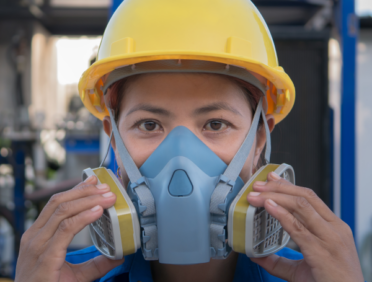Health and safety is an important part of any workplace. The right guidance is vital for making sure that workers are protected and that they have the freedom to go about their jobs without the imminent risk of harm.
It is the responsibility of employers to make sure that there are suitable health and safety measures in place to protect staff from the risk of harm. This is a legal requirement and will heavily influence your reputation as a business simultaneously. Let’s take a look at what you’ll need to know.
What is Health and Safety in the Workplace?
Health and safety in the workplace is a term which generally refers to the legal requirements that a business has under the Health and Safety at Work Act 1974.
When we talk about the term “health and safety”, we’re typically referring to occupational health and safety. This is a multidisciplinary field which is all about the prevention of both ill health and accidents in the workplace. The provision covers both employees and any other parties who might be affected by their work.
The typical dictionary definition for health and safety is the following:
‘Regulations and procedures which are intended to prevent accidents and injuries in either public environments or the workplace’.
When talking about health and safety, the 1974 act is referenced a lot. It is a piece of statutory legislation which came into prominence as a result of a report that highlighted the dangerous working conditions many faced.
Before we had the Health and Safety at Work Act 1974, occupational safety was covered by both the Factories Act 1961 and the Office, Shops and Railways Premises Act 1963. Both of these pieces of legislation have been phased out through amendments and updates over the intervening decades.
Both employers and employees have different responsibilities under the Health and Safety at Work Act 1974. They also have to adhere to any piece of Health and Safety legislation which has come into effect since then.
The Health and Safety at Work etc Act 1974
The Health and Safety at Work Act 1974 is known by many names – HSW, HSWA and HASAWA are just a few. It is an official Act which was created to lay out a framework for managing both workplace health and safety in the UK.
The act has been created to define the general responsibilities of everyone in the workplace, from employers, employees, owners, managers and maintenance staff. Each one has a given responsibility under the act when it comes to maintaining health and safety.
When working in high risk environments, like many specific business sectors that work in construction or chemical manufacturing, there is further legislation designed to support those specific environments.
As an act, the legislation has been approved by the government. Other regulations which appear are considered complementary to the original act. We call these statutory instruments, which are essentially any auxiliary pieces of legislation which pertain to the original document.
Statutory instruments have been designed to make small amendments and changes to the existing legislation. This is the way changes are made without the need to make a new Act each time.
The Act and all of its many regulations are properly enforced by the Health and Safety Executive. This is the official body appointed by the government for this task. However, within the context of enacting the enforcement of the legislation, the responsibility typically passes between the HSE itself and any relevant local authorities as necessary.
The Health and Safety at Work Act 1974 is understood to be the primary piece of legislation for both occupational health and safety in the UK. However, it is also important to note that there are other regulations which have been designed to make sure that workplaces remain compliant and safe.
It is important to understand the key points that the Act outlines, as compliance is a legal requirement. However, it is also possible that you will need to seek out more specific regulations, which are dependent on the specific area of business that you operate in.
The guidelines insist that the workplace provides squeeze training of all staff to make sure that the proper health and safety procedures are not only understood, but adhered to.
There should also be adequate welfare provisions made for all staff in the workplace, and a safe working environment needs to be created where it is maintained properly and the operations within it are conducted in a safe manner.
Employers are expected to provide a suitable level of provision for obtaining information, supervision and instruction. If the workplace has more than five employees, employers have a responsibility to keep written records of the health and safety policy that is in place, and should also consult with either employees or their representatives regarding the relevant policies and arrangements pertinent to the specific health and safety needs of the workplace.
The regulations clearly state that the working environment needs to be properly maintained, and the various regulations apply to all areas. The employer has a responsibility to not only create a workplace that is safe, but also suitable for staff to perform various tasks.
This can range from a variety of provisions designed for sanitation and comfort of the employees like washing facilities, drinking water and break areas. It also applies to making sure that there is provision for suitable working environments like proper room dimensions and ventilation. Finally, it refers to any provisions that need to be made for safety in the workplace, which includes things like properly maintained floor space, protection from any falling objects or the appropriate maintenance of equipment used by staff.
Safe System of Work
A safe system of work is a formal procedure that has been created based on a proper evaluation of the work done to identify hazards.
The procedure helps to clearly define safe methods of working. These methods help to minimise the risks associated with hazards or eliminate them outright. To put it another way, safe methods of working or a defined method for doing the job in a very safe way.
Employers have a responsibility to make sure that safe systems of work are available for all the activities that take place. In much the same way, employers have a responsibility to carry out a proper assessment to identify these work activity risks in the first place.
Health and Safety Policy Statement
The law clearly mandates that every business needs to have a policy for managing health and safety in the workplace. A general safety and health policy will outline your specific approach to health and safety as an employer. It clearly explains how you will manage health and safety in the business as the employer.
If you’ve got more than five employees, then you have to write down the policy. If you don’t have more than five employees, you don’t have to write down your policy, but it can be helpful to do so.
As the employer, you have a responsibility to identify risks and conduct risk assessment. This means that not only do you need to identify any potential risks in the workplace, but you have to create and implement control measures that will help to prevent these risks.
Whether this is accomplished by providing staff with more training, replacing equipment, or developing health and safety practices, it’s your job to manage the risks. You have a legal obligation to conduct a risk assessment and manage risks effectively.
How to Use Safe Methods
By referring to official government guidance on the subject, he will be able to gain information about how to properly create safe working methods. It’s your responsibility to then make sure that your staff are educated on how these methods will be used in the workplace.
You have a legal responsibility to make sure that safe methods are created and implemented across the workplace. It’s important to give staff the proper training that they need to do so.
Capability Assessment for Vulnerable Workers
As part of your responsibility as the employer, you have to conduct what is known as a capability assessment for vulnerable workers. Vulnerable worker is classed as someone who has a physical or mental impairment that might restrict their ability to work. Examples of this can include people with mental health issues, pregnant women, or anybody with a physical handicap.
As the employer, you need to make sure that you fill out the assessment to identify how much responsibility the vulnerable worker can safely handle. You will be at fault if you knowingly expose vulnerable workers to more responsibility or behaviour than they are capable of taking on.
In most situations where an accident takes place in the workplace, you need to report it. This means filling out the appropriate information, and making sure that the accident is well documented, including who was injured, what the final result was, and what action you are taking as the employer to make sure it doesn’t happen again.
In many cases, an accident often calls for a review of the health and safety policy as well as the risk assessments that have already been taken. Naturally, the aim of this will be to make sure that the risk assessment in question successfully mitigates any potential issues.
Chemical Safety
Chemical safety is an important part of successful business practices in the workplace. As the employer, you have a responsibility to understand and interpret the specific legislation related to the using, storing or manufacturing of chemicals in the workplace.
This information needs to be used in the health and safety policy that you create, and should then be disseminated to all employees in such a way that it is understandable.
First Aid at Work
First aid in the workplace is covered by The Health and Safety (First-Aid) Regulations 1981. This guidance stipulates what employers need to do for first aid provision in a work environment.
It provides key guidance on managing the provision of first-aid materials, making sure that people are trained to be first-aid responders, making sure that there are enough appointed persons on site at any point, and making sure that employees are aware of the first aid rules and procedures.
Fire Risk Assessment
Every workplace, regardless of what it does, must complete a fire risk assessment. This document will identify areas where potential fire risks are, make sure that there are fire prevention tools on hand, that the workplace has clearly defined fire escape routes, and regular fire drills are conducted.
This is usually at the discretion of the employer to sort out, but in some cases they may appoint a staff member to receive training in fire-related health and safety protocol.
Good Practices
When it comes to health and safety in the workplace, employers have a responsibility to try and design their workplace environment in accordance with good practices. For example, this means creating shifts that are no longer than 12 hours at a time, and making sure that staff have the freedom to choose shifts where appropriate.
They also have their responsibility to make sure that a welcoming, safe and supportive work environment is created, which involves in most cases providing free health assessments for shift workers, and making sure that the relevant mental health support is available.
Legal Requirements
As the employer, you have a responsibility to carry out health and safety risk assessments. This is your legal obligation.
In addition to creating a health and safety policy as a result of the risk assessments, you have to put control measures in place that will protect workers from the hazards outlined in the risk assessment. Furthermore, it is your duty to review the risk assessments that have been completed in the event of an accident. If you don’t do this, you have to nominate and train a worker to do it for you.
Health and Safety Posters
As part of your legal requirements to health and safety, each workspace needs to have a clearly displayed health and safety poster that is available for staff to examine. Generally speaking, it is worth purchasing one of these from an official source, and installing one on each individual work area to make sure that there is no risk of not fulfilling your obligations. These posters must be used in addition to any existing health and safety policy or risk assessments, and not as a substitute.
Procedures and Policy
In the context of health and safety, the policy is the document that you create as the employer which outlines your approach to health and safety, in keeping with all current legal regulations and obligations.
The procedures that you implement other things that you do to guarantee health and safety in the workplace. This could be things like introducing certain control measures, instructing staff on safe usage of equipment or working procedure, and any other protocol that needs to be followed in the workplace for a given event.
Record Keeping
Record keeping is an important part of health and safety in the workplace, and governs many different areas. You have an obligation to keep records of your risk assessments if there are more than five employees on the site, as well as the health and safety policy.
While you are not under any obligation to keep records of health and safety or policies if there are less than five employees in the workplace, it’s still recommended that you do so for added security and making sure that everybody understands the rules.
Training and Supervision
You have a responsibility to educate staff members on their health and safety obligations, and to make sure that everybody is training for the sake of adhering to the health and safety policy. Something else that you need to make sure staff have is adequate supervision by managers and experts who can monitor the workplace for violations of the health and safety policy.
Learn Q provides health and safety training in the workplace which is designed to make sure that staff get the knowledge they need to make smart decisions. It is important to understand that staff have an obligation to understand the health and safety obligations, and you, as the employer, are responsible for ensuring this. We can happily provide your team with full training in health and safety.
To download a .pdf of this blog, please click here











